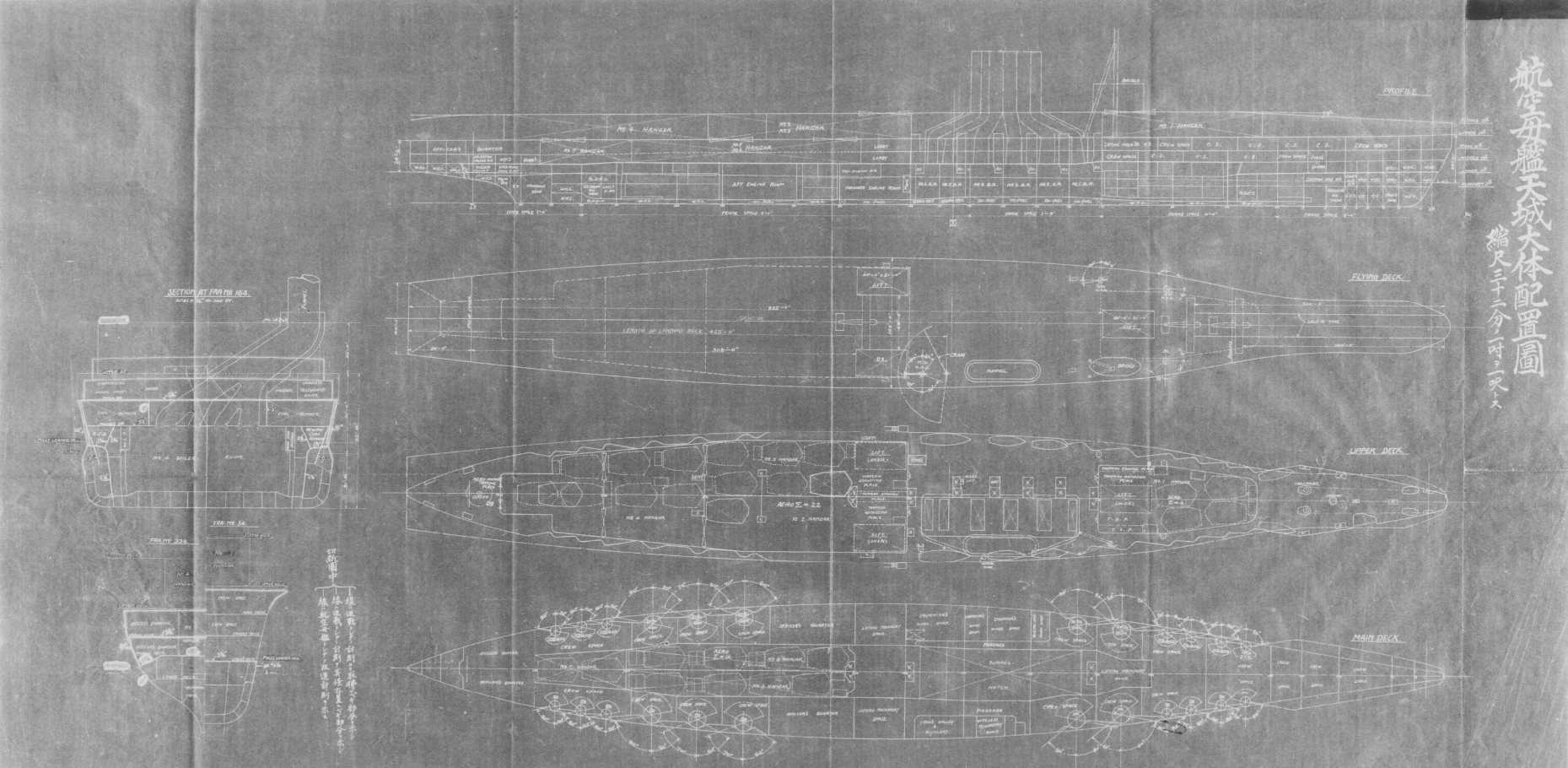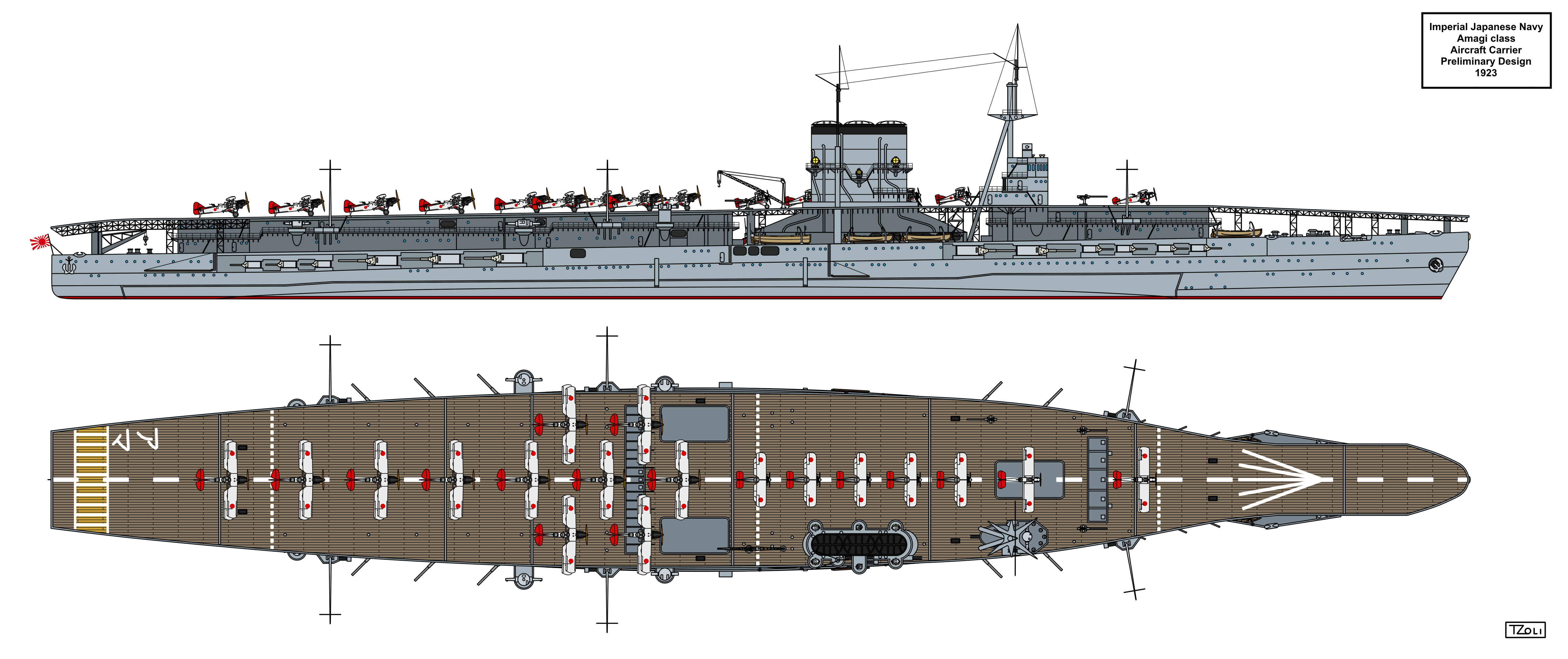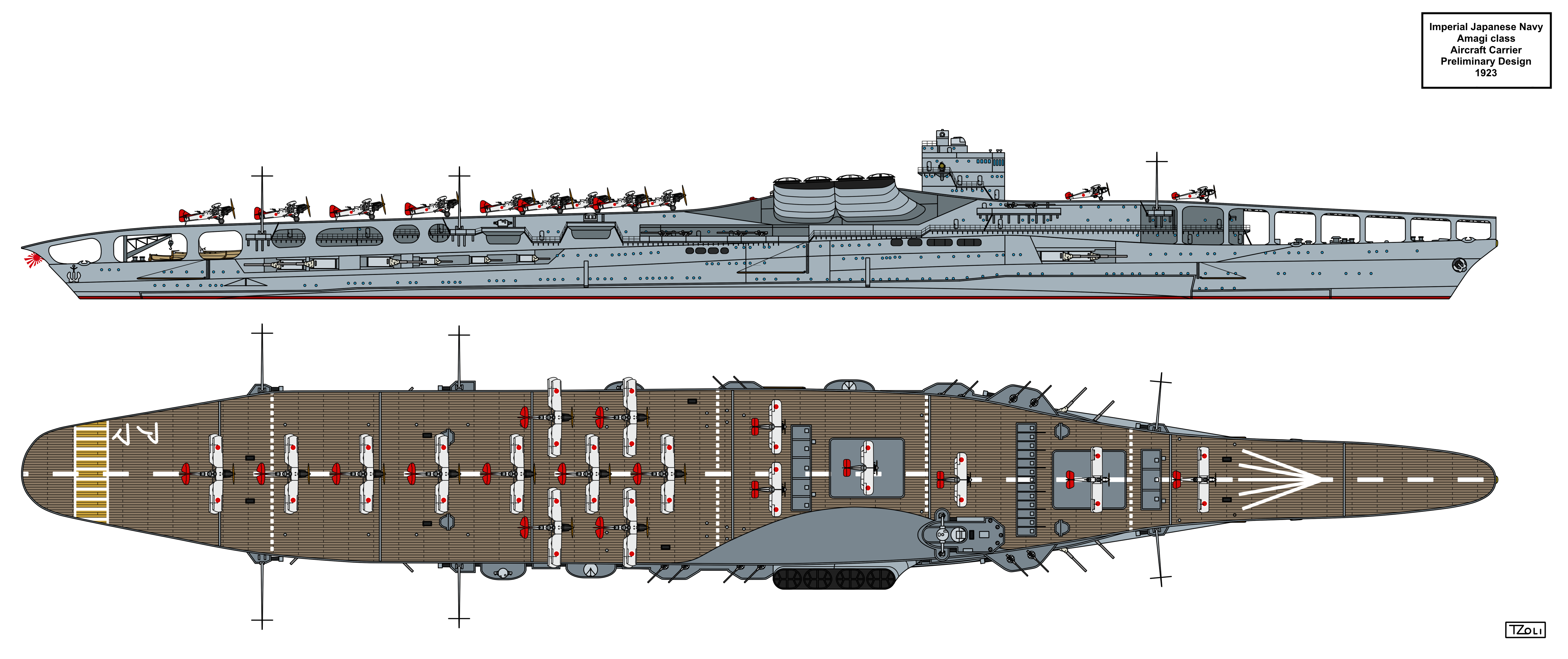It is an often overlooked snippet in warship history that the US Navy’s and the Imperial Japanese Navy’s carrier vessel evolution was remarkably similar. This was in part due to the restrictions imposed by the Washington Naval Treaty’s sanctions but even then the design decisions and the ships built subsequently shared a lot in common.
Just as with the US Navy before the Lexingtons, the Japanese were looking at carrier designs utilizing the most suitable hull design, that is of it’s new 16″ battlecruisers hulls. So it was no wonder that when these said hulls became superfluous some carrier conversions were drawn up, resulting in what became the Akagi.
First of the preliminary proposals to convert the Amagi class Battlecruisers IJN Amagi and Akagi to aircraft carriers this early implementation showed a hangar capacity of only 36 torpedo bomber sized aircraft (Mitsubishi B1M). There is a large unoccupied space around the funnel uptake with 7 small hangars distributed among 3 larger spaces in the hull: one forward for 4 aircraft (No.1), one aft for 22 aircraft (No.2-4) and one below the after one (No.5-7) for 10 aircraft.

The most prominent differences between this design and what actually became the Akagi are the large funnel reminiscent of the USN’s Lexington class, a bridge superstructure separated from the funnel, four single 12cm AA guns on the flight deck (instead twins on sponsons), one deck higher main deck for housing the crew and a flight deck that was still lower in height then in the Akagi. Finally a more numerous casemated battery rounded it out: all 20cm guns in casemates with an extra 7x 12cm on each side.
While the data page shows 36 bomber aircraft as it’s air group a mixed set up based on the following types is more likely :
4x Mitsubishi C1M Scout planes
10x Nakajima A1N Fighters
22x Mitsubishi B1M Bombers

Dimensions: 235 (pp) 249 (wl) 258,2m (oa) x 33,5 (at bulges) x 6,58m
Displacement: 29.600tons (standard), 33.000tons (full load)
Armour: 127mm Belt, 79mm Deck
Engines: 131.200shp, Gihon steam turbines, 4 shafts
Range: 14.800km at 26km/h (8.000nm at 14knots)
Speed: 57km/h (31,75knots)
Armament:
10×1 20cm/50 Type 3 (3rd Year Type No.1) Casemated Guns
14×1 12cm/45 Type 10 (10th Year Type) Casemated Guns
4×1 12m/45 Type 10 (10th Year Type) AA Guns Airgroup: 36 aircraft

In the second iteration some new features have been added: –
- a shorter funnel that is further forward, plus an auxiliary one blowing to the starboard, presumably to be used when flight operations are on
- the casemate guns have been moved much closer to the center of the ship possibly to improve their effectiveness in rough weather (they are still higher then on Akagi as built)
- a longer and fuller (forward) flight deck, though it’s height further reduced
- the AA guns moved slightly forward and while the original drawing does not show a bridge, the angle of fire of the forward AA guns as well as the existence of the funnel meant there ought to be one (it is possible it got moved under the deck on the sides to further reduce topweight)
- stern changed to similar shape as Akagi as built ie. a cruiser type stern rather a straight one
The design had the following characteristics:Dimensions: 235 (pp) 248 (wl) 264,5m (oa) x 33,5 (at bulges) x 6,58m
Displacement: 29.600tons (standard), 33.000tons (full load)
Armour: 127mm Belt, 79mm Deck
Engines: 131.200shp, Gihon steam turbines, 4 shafts
Range: 14.800km at 26km/h (8.000nm at 14knots)
Speed: 57km/h (31,75knots)
Armament:
10×1 20cm/50 Type 3 (3rd Year Type No.1) Casemated Guns
14×1 12cm/45 Type 10 (10th Year Type) Casemated Guns
4×1 12m/45 Type 10 (10th Year Type) AA Guns Airgroup: 36 planes (probably)

This is yet another design of the Amagi class carrier conversion proposals and one of the most unique ones with it’s large armored funnel casing blending outward from the flight deck. Still you can see many aspects which were integrated into the final Akagi:
– the aft positions of the casemates
– one single large outward angled funnel
– final number of 6x 12cm AA guns per side
Dimensions: 235 (pp) 248 (wl) 268,5m (oa) x 38 (at sponsons and funnel) x 6,58m
Displacement: 29.600tons (standard), 33.000tons (full load)
Armour: 127mm Belt, 79mm Deck
Engines: 131.200shp, Gihon steam turbines, 4 shafts
Range: 14.800km at 26km/h (8.000nm at 14knots)
Speed: 57km/h (31,75knots)
Armament:
10×1 20cm/50 Type 3 (3rd Year Type No.1) Casemated Guns
6×1 12cm/45 Type 10 (10th Year Type) Casemated Guns
12×1 12m/45 Type 10 (10th Year Type) AA Guns Airgroup: 36-40 planes (probably)

By removing the bridge and angling the deck to fully overlap the funnel casing allowed a much larger deck space, on the other hand this seems to be the first design incorporating the idea of a multi deck carrier for the IJN.
This is a twin deck carrier design with a spacious part allocated as the commanding bridge.
The main or top flight deck might be used for the launch of the first strike wave of aircraft, though it’s primary function was to recover the aircraft for which the almost ski-jump like angle could help slow and stop them. The existence of a single elevator only would suggest this as well.
The primary take off deck was on the lowest level just above the bow, though due to the AA gun placement there the take-off would be a bit more complicated in strong winds, as there are less side-way space there.
While the original drawing does not show (but the one after this design does) it is logical to assume that the space for the bridge would also house the directors and rangefinder(s) of the main 20cm guns. This would also explain the funnels reduced height to be just barely above the flight deck and thus it would not hamper the line of sight.
Dimensions: 235 (pp) 248 (wl) 268,5m (oa) x 38 (at sponsons and funnel) x 6,58m
Displacement: 29.600tons (standard), 33.000tons (full load)
Armour: 127mm Belt, 79mm Deck
Engines: 131.200shp, Gihon steam turbines, 4 shafts
Range: 14.800km at 26km/h (8.000nm at 14knots)
Speed: 57km/h (31,75knots)
Armament:
2×2 6×1 20cm/50 Type 3 (3rd Year Type No.1) Turreted and Casemated Guns
6×1 12cm/45 Type 10 (10th Year Type) Casemated Guns
12×1 12m/45 Type 10 (10th Year Type) AA Guns Airgroup: 36-40 planes

By elevating the flight deck supported by beams and other structural elements the landing of aircraft became much more simple and potentially more safe. At the same time the entire bridge together with the twin turrets were moved forward and so the flight deck extended aft resulting in even more flight deck space. Armament wise the only change was the introduction of the twin 12cm DP-AA guns in open mounts on the same places as before ie 2 under the forward flying off deck, and 2-2 at each sides after the funnel. A more refined version of this design exists where the after part of the flight deck squared off, the aft part of the hull cut one deck level and the arrangement of the AA guns became symmetrical.
By using the space below the flight deck for a second level hangar and re-arranging the inner structure the aircraft capacity was doubled!
One can clearly see how the final Akagi evolved from these last two designs. To make the flight deck free of obstacles and fumes the funnel was bent down and sideways though this resulted the fumes reaching the port side AA guns hence the creation of the first fully enclosed DP-AA mount for the IJN.
Dimensions: 235 (pp) 249 (wl) 275m (oa) x 39,5 (at sponsons and funnel) x 6,58m
Displacement: 29.600tons (standard), 33.000tons (full load)
Armour: 127mm Belt, 79mm Deck
Engines: 131.200shp, Gihon steam turbines, 4 shafts
Range: 14.800km at 26km/h (8.000nm at 14knots)
Speed: 57km/h (31,75knots)
Armament:
2×2 6×1 20cm/50 Type 3 (3rd Year Type No.1) Turreted and Casemated Guns
6×1 12cm/45 Type 10 (10th Year Type) Casemated Guns
6×2 12m/45 Type 10 (10th Year Type) AA Guns Airgroup: 60+ planes